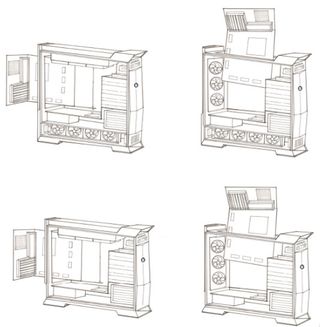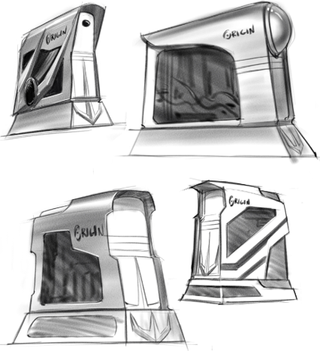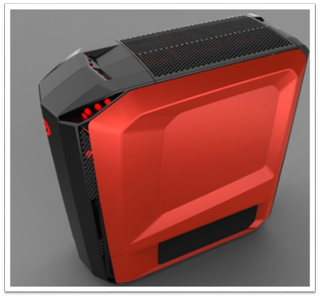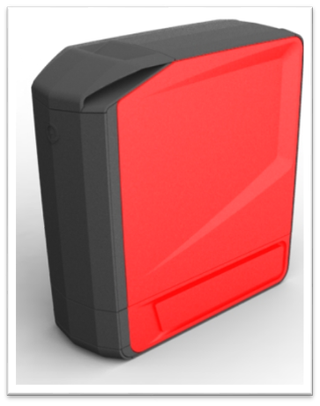Origin PC Shows Us How To Build A Case With Project Prime
Origin PC’s Home-Grown Chassis

I’ve toured motherboard manufacturing facilities. I’ve seen memory modules assembled. And I’ve watched graphics cards pieced together. But I cannot say that I’ve ever traced the process by which computer cases are built.
A few months ago, though, boutique builder Origin PC approached me about a super-secret project it was preparing to showcase at CES. The company was in the final stages of designing its own case that would feature support for up to four-way SLI, large E-ATX motherboards, and as many as three 360 mm radiators. Flexibility was the goal—Origin PC also wanted its mid-tower chassis to convert to a functional full-tower and accommodate four different motherboard orientations for optimizing air flow and customers’ window preference. Almost three years passed between conceptualization and the launch at CES 2014.
In our discussions, representatives referred to the project by its code name, Prime. We now know the mid-tower is branded as the Millennium and the full-tower config is Genesis.
Understandably (but still unfortunately), Origin PC isn’t making these enclosures available to enthusiasts on their own, so we can’t really review them on their own merits. Rather, we’ll be looking at them housing complete PCs in the weeks to come. In the meantime, though, I wanted to give Origin PC an opportunity to show the Tom’s Hardware audience how a case goes from idea to production using its Millennium and Genesis as examples. What follows is from the Origin PC team's point of view.
--Chris Angelini
It Starts With Cardboard...

June 2011: A generic-looking cardboard mock-up was first created to represent the initial idea of a desktop that supports up to four different motherboard configurations with a lower detachable compartment to serve as the system’s base for additional cooling components or storage drives. Then, an acrylic model (pictured) was built based on the cardboard version’s dimensions as “proof of concept”.
Getting The Goals On Paper

July 2011: We represented the overall ideas into a very rough, not-to-scale sketch.
Stay on the Cutting Edge
Join the experts who read Tom's Hardware for the inside track on enthusiast PC tech news — and have for over 25 years. We'll send breaking news and in-depth reviews of CPUs, GPUs, AI, maker hardware and more straight to your inbox.
Giving Prime A Personality

August 2011: After defining some of those main features at a very early stage, we started researching and creating an ID that would fit the Origin PC brand.
Reigning It In With Something More Realistic

December 2011 to June 2012: We decided that the early concepts were too futuristic-looking, so we chose to take a different design path with a more aggressive look.
Designing With Modularity In Mind

August 2012: After landing on the preferred design concept, we continued to refine the Millennium mid-tower and Genesis full-tower. In this shot, you see the expansion bay on the bottom of Prime, which converts it from a mid- to full-tower form factor. We knew that this was going to be a big part of the system and didn’t want it to feel like it didn’t belong when it was a full tower or like it was missing when it was a mid. Making the system feel whole when it was in both its forms was a key part of the design phase.
A Functional Interior Takes Shape In 3D

November 2012: A lot of work went into turning our sketches into 3D models. At first, they didn’t look anything like what we wanted. Additional revisions helped accommodate our design goals. Once those updates started getting closer to what we needed, we were able to build the internal metal frame and plastic panels in 3D, which is what you see here.
Is It Practical To Manufacture, Though?

Next, we had to evaluate the system renders to determine whether the concept could be manufactured. We wanted an aggressive, powerful look. The forward-leaning side profile is meant to convey speed-in-motion and performance.
From Digital To Physical

February 2013: The first foam prototype design files were generated and sent to the prototyping facility...
Giving The Foam Some Color

February 2013: ...and then we added our red and black branded colors to the foam. In this shot, the foam had a different full-tower expansion bay to help us decide which style we liked the most.
Now That Looks Like A Real Case

October 2013: It turned out that multiple revisions were needed to make Project Prime something we could actually manufacture without affecting the approved industrial design. This was our first prototype.

Museum criticizes Microsoft for 'mutilated' MS-DOS 4 open source release — posting on 'stupid' git blamed for the buggy blunder

Intel issues statement about CPU crashes, blames motherboard makers — BIOSes disable thermal and power protection, causing issues

ASML claims US ban on servicing China chipmaking tools will not hurt the company
-
MxMatrix Awesome, nice view of the development process ... Looks like Origin is dethowning Alienware slowly on design cases.Reply -
user 18 This does feel similar to the Tiki article, although the Tiki was focused on the entire system and the interplay of its components in a small space, while this is focused on just a flexible case. I was hoping for a more in-depth look, and not a picture story either.Reply -
cangelini ReplyOh look, an advertisement--I mean article--for a sponsor.
Origin came to us wanting to talk about the company's new case, and I came up with an educational angle relating to case development. Our editorial team is separate from the ad guys.But didn't you guys cover a similar process for the Tikki?
We did something different with the Tiki. In fact, the interest in that piece was what got me thinking about ways to do this one--I wanted it to be different. -
Bondfc11 What an ugly, ugly BORING case. Wow so impressive - another rectangle with some hard edges. Nothing to see here folks, keep moving . . .Reply -
Jeffrey H ReplyWhat an ugly, ugly BORING case. Wow so impressive - another rectangle with some hard edges. Nothing to see here folks, keep moving . . .
Well look at it this way, I have a Case that is simple, and not some "Eyesore" that some of these cases are made, the fact is good I have a CPU that currently is both Powerful, but also both Energy Efficient and Quiet too which makes it worth it, some of these Cases I see probably do little to Isolate Noise. -
ticho66 These type cases remind me of the last big ugly gas guzzling American cars. You know the "battleships" with some fins or an odd rounded edge. The death rattle of the American car makers' arrogance. These cases are the same thing. A few angles and areo-dynamic flair on a dying paradigm.Reply -
Emanuel Elmo and yet all i want is the case. Who cares about the hype when you can not just purchase the case.I don't want to buy a full blown pc from them to get the case. The case is what is important.Reply -
clonazepam ReplyAwesome, nice view of the development process ... Looks like Origin is dethowning Alienware slowly on design cases.
It's just my opinion of course, but Alienware has always had awful looking cases. -
rRansom ReplyWhat an ugly, ugly BORING case. Wow so impressive - another rectangle with some hard edges. Nothing to see here folks, keep moving . . .
Not sure if trolling or...But really, it's not that bad of a case. Just imagine the possiblity of it having four different orientations, without having to do some major hardware modifications to make it happen . Like Emanuel Elmo, I'm also interested in getting just the case. The only time the case would not make sense was if you wouldn't be filling her up to the bring. Then again, I'd probably go with a CaseLabs STH10. :)
Most Popular



